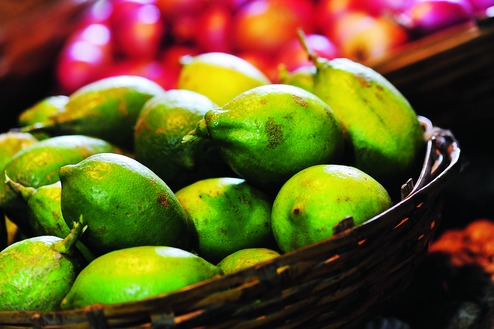

The gondhoraj, quite literally means the sultan of aroma. Even king of fragrance is a fair translation but it doesn't really do justice to the majesty of it.
We are, of course, talking limes. From the football-sized grapefruit to the golf-ball sized acid lime, India has been blessed with plenty. There is the large, loose-skinned Nagpur orange, the yellow-green mosambi, the juicy kagzi, the small but sweet Darjeeling orange, naarthangai that is always pickled, the large, slightly bitter chakotra or pomelo, the Malta that grows in the northern hills, the sweet-tart sweet lemon grown mostly down South... But none of these compares to the innate kingliness of the gondhoraj.
Most traditional meals in eastern India, celebratory or otherwise, start with a wedge of lemon and a pinch of salt. If you did not want to squeeze the tart fruit over any of the dishes, you could always use it at the end to wash the oiliness off your hands. Intimate meals always feature the gondhoraj - in a bowl that it shares with green chillies.
Considering the sheer variety of limes available in India, it is a mystery why it is used so little in cooking. It is tamarind that is the primary souring agent in eastern India, yoghurt in the north and kokum in the South - the lime is restricted to sherbets and pickles.
Not that the gondhoraj would be a great souring agent - it tends to lose its beautiful fragrance when heated. Says food historian Pritha Sen, "The lime has always been used as a condiment, never the star ingredient." But that might be changing.
Pass a grove of gondhoraj - or even a single tree - and, like a royal fanfare, it announces it presence with a whiff of that distinct scent - clean, citrusy, with an undertone of floral sweetness.
This fragrance is most intense in the oval, bright green and shiny leaves - in fact, they were used to flavour the gondhoraj bhaat, where the leaves are layered with the rice. When there were no limes in the garden, the leaves were used to flavour the pulses - masur dal or bhaja moong dal.
The dark green limes are, of course, always in great demand. As they ripen, they turn a smooth light green and acquire a little juice. Not that you want a whole lot of gondhoraj juice - it is extremely sour. The gondhoraj, like kingly favour, is best savoured in small doses.

The gondhoraj is actually a native of Rangpur, a hilly area in the northern part of Bangladesh - bordered on one side by Assam and the other by West Bengal - with rich golden soil. It used to grow wild there.
It was possibly a poor foodie who discovered that his simple meal of overnight rice ( panta bhaat) and green chillies became a feast for the senses when flavoured with the leaves of the hardy lime tree.
The Rangpur lime, a natural hybrid born off a Mandarin orange and a citron, has been known in Indian cuisine since the Mughal era, says Rishi Krishna De, assistant director in the department of agriculture of the West Bengal government. It has since migrated to the tables of the rich and thence, in the recent past, to the kitchens of fine dining restaurants.
Found in the eastern part of the country, it is grown commercially in Bengal, Assam and Tripura, as well as in gardens across the country.
All the citrus fruit in the world can trace their roots to the Indian subcontinent. In fact, it was the citron - father of the gondhoraj - that first travelled out of India with Alexander the Great. When it reached Europe, it was named the Citrus medica for its curative properties. The Rangpur lime, too, has travelled; among other places to Florida in the US, where it is called the Mandarin lime and grown primarily as a hardy ornamental plant that can withstand low temperatures.
If you Google Rangpur lime, scientific name Citrus limona, you are sure to be disappointed. It shows a round, orange fruit that looks nothing like the green, oblong, thick-skinned gondhoraj we know and love. Pictures do not say the whole story; if you can lay your hands on a Rangpur lime, you will recognise its sweet, citrusy fragrance at once.
" Gondhoraj limes are plucked before they ripen. That is why they are green in colour," says De. "If left to ripen on the tree, they will turn bright yellow." The gondhoraj that is commercially grown is usually not pure Rangpur lime but lime that has been cross-bred to be smaller in size.
The thick-skinned fruit is a table lime, its fragrant but scanty juice usually squeezed over rice. At most, it is used to flavour buttermilk ( gondhoraj ghol) or sherbet. It is its leaf that is used to flavour dal or rice. In that, it resembles its cousin, the Kaffir lime, used generously in Thai cuisine. The rough-skinned Kaffir lime itself is, however, pruned off to get a more lush growth of leaves.
These days, however, the gondhoraj is flavouring a host of dishes - from the pioneering Gondhoraj Bhetki to Gondhoraj Chicken to Gondhoraj Sorbet to Gondhoraj Mousse. Vegetable dishes and cocktails, too, have not escaped its influence.
"The trick to the best flavour profile from gondhoraj is to get fresh, quality limes and use them fresh," says Joymalya Banerjee, chef-owner of the contemporary Bengali cuisine restaurant, Bohemian, in Ballygunge, Calcutta. "Steaming or heating it to high temperatures kills 90 per cent of the gondhoraj flavour," says the man who came up with the recipe for Gondhoraj Bhetki when he was the head chef of the Bengali fine dining restaurant, Oh! Calcutta. "You can say I was the one who started this trend," he says, while pointing out that the idea was Anjan Chatterjee's, the man who owns the Oh! Calcutta chain.
Chatterjee once admitted to The Telegraph his obsession with the king of flavour and his tendency to "follow every waft of citrus scent borne in by the sea breeze", looking for the elusive gondhoraj. That is how he discovered that apart from the Kaffir lime, the gondhoraj has cousins in China (Canton lime) and Japan (hime). These are varieties of the same family of Rangpur limes, as is the Limao cravo found in Brazil and the Mandarin lime in the US.
Replication is the best form of flattery and Chef Joy has got a lot of that. He, however, feels that none of the dishes has been able to get or consistently maintain the flavour profile of the Gondhoraj Bhetki of Oh! Calcutta. As for the Bohemian menu - tired of being referred to as the Gondhoraj Man, a name chef Karen Anand bestowed on him - the chef has taken a few of the gondhoraj dishes off the menu. Yet, the day we visited Bohemian, Gondhoraj Julep was the most ordered mocktail.
Bohemian has another popular cocktail, the Gondhoraj Martini. It is flavoured with Gondhoraj Limoncello brewed under Chef Joy's supervision. The lime-rimmed martini glasses add another layer of flavour to the drink.
Should not the aroma that improves everything from chicken to alcohol to dessert be given global recognition? Why then has the gondhoraj remained a local phenomenon? According to Chef Joy, that's because no one has yet been able to bottle the volatile oils of the fruit. Without that it is not possible to take the gondhoraj to foreign shores.
Agriculture scientist De says gondhoraj stays fresh long enough to be exported but there is no demand for it because it is difficult to squeeze the juice out of it. Gondhoraj lemonades, however, are doing brisk business in foreign lands.
While we in India are still discussing the possibility of making the gondhoraj a global flavour, a British company has beaten us to it. Liquor company Diageo has been marketing the Rangpur lime-flavoured Tonquaray Rangpur since 2006. Made in Scotland, this citrus-flavoured gin is most popular in the US. As is the Rangpur lime marmalade - the only way the Americans have made the tart limes palatable.
The gondhoraj can only grow in soil that is rich and dark. That is why the Rangpur lime thrives in the dark, volcanic soil of Hawaii, as it does in eastern India. There, the king of fragrance is affectionately called the Kona lime. It is as beloved as the gondhoraj but it is not " gondhoraj".
The sultan of aroma remains rooted firmly in the clayey soil of the Ganga delta.











